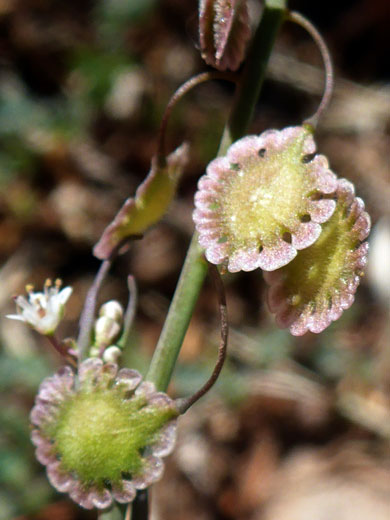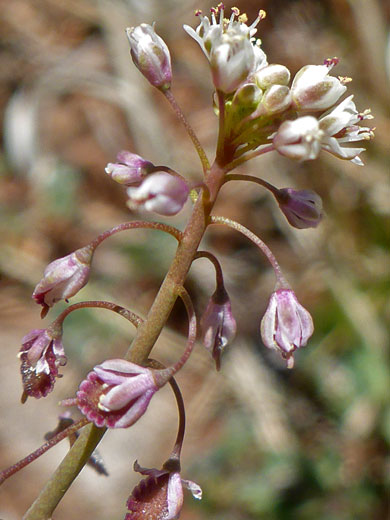Common names:
Sand fringepod, lacepod
Family:
Scientific name:
Thysanocarpus curvipes
Main flower color:
Range:
The Pacific and Great Basin states, Arizona and New Mexico, and small areas of Montana and Colorado
Height:
Between 5 and 30 inches
Habitat:
Rocky slopes, moist sandy locations, streambanks; up to 4,000 feet
Leaves:
Basal leaves are oblanceolate, usually up to 2.5 inches long, with lightly hairy surfaces and small teeth along the edges
Season:
January to June
Flowers of thysanocarpus curvipes are tiny, formed of four purplish sepals and four white (sometimes tinged purple) petals less than 0.2 inches long; most visible are the disc-like, green to purplish seed pods that hang down from short stalks, at alternate intervals below the compact, terminal flower cluster - extending over half or more of the stem. Pods are slightly raised in the center, and have wavy, white, scalloped edges, with a neat ring of small holes near the margin.
Basal leaves are widest towards the top, have fine edge teeth, and short hairs on both surfaces, while the smaller stem leaves are widest towards the base, and clasp the stem. This species has a wide geographic range but is often overlooked owing to the small, short-lasting flowers, the slender, unbranched stem, and the mostly basal leaves.
Basal leaves are widest towards the top, have fine edge teeth, and short hairs on both surfaces, while the smaller stem leaves are widest towards the base, and clasp the stem. This species has a wide geographic range but is often overlooked owing to the small, short-lasting flowers, the slender, unbranched stem, and the mostly basal leaves.
All Contents © Copyright The American Southwest | Comments and Questions | Contribute | Site Map





